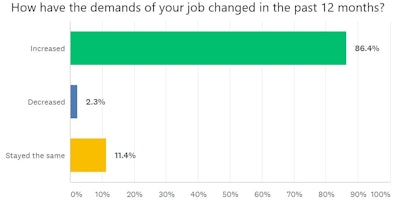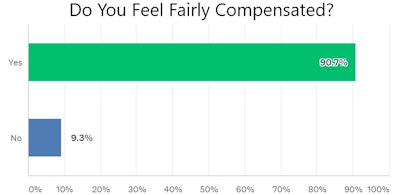
Money Talks
The issue of salary and compensation levels are currently sandwiched between two prevailing economic conditions: the trailing effects of the COVID-19 pandemic on business’ profits and payrolls, and modest inflation that some analysts think is more than just a temporary side effect of a rapidly recovering US economy.
As one of our many annual reports, we at Industrial Distribution use our Salary Report as a way to provide the industrial distribution market with a snapshot of current compensation rates and how the industry’s workforce feels about them — segmented by three tiers of job titles. Money certainly isn’t everything to distribution employees, but in an industry that has struggled to recruit and retain Millennials and now Gen-Z talent that is far more prone to job-hop than older generations, the almighty dollar is often an employer’s most valuable asset.
The US Bureau of Labor Statistics’ employment report issued July 2 showed that American workers are enjoying an upper hand in the job market, with average hourly wages up a solid 3.6 percent in June compared to a year earlier. Some economists have pointed to wage gains as an equal or bigger factor in inflation than rising commodity prices.
The 2021 ID Salary Report is based on a survey distributed via our digital channels of email, our daily e-newsletter and social media and conducted throughout June. The results are divided into three separate categories based on where respondents identified their specific job functions.
Though this is a long-standing survey, it was not conducted in 2019 during ID’s transition to a new publisher.
The following results are based on three separate sets of data from Executives (Owner, Chairman, CEO, CFO, CIO, COO, President or VP); Mid-Level (non-sales) Management (Product, Operations, Branch and/or Purchasing); and Sales Representative/Manager. This year’s split of more than 200 respondents came at 27 percent executives, 33 percent mid-level management and 40 percent sales rep or sales management. Overall, 85 percent of respondents were male, and the pool’s age breakdown was fairly evenly split at 22 percent under 40 years old; 21 percent at 41-50; 29 percent between 51-60; and 28 percent above 60.
Here in Part 1, we'll cover the results from Executives. Check out the Mid-Level Management results here, and the results from Sales/Sales Management were posted Thursday.
Executives
Ninety-one percent of respondents who identified themselves as “Executives” are male, up 2 percentage points from last year and within the 89-95 percent range seen in our survey over the past decade. The portion of female executives recently peaked at 11 percent in 2015. Exactly 80 percent of executive respondents are at least 50 years old, and 49 percent are older than 60 — which means many distributors will be tasked with transitioning key leadership positions amid retirements over the next decade. This is expectedly the most highly-educated of our three respondent segments, as more than 71 percent of our executives have at least a college degree, and 24 percent own an advanced degree.

This year’s group of executives report an average base salary of $152,000 — down considerably from last year’s $173,000. This year’s median salary is $138,000, ranging from $55,000 to $375,000. For those who earn commission, their average commission is just under $97,000, bringing this group’s overall compensation pay package to an average of $249,000. That’s a decent step down from last year’s average of $266,000, and still down considerably from the $297,000 and $287,000 seen in 2018 and 2017, respectively. Overall, this year and 2020’s base salary averages were down from the pre-pandemic years of 2015-2018 by a sizable margin, while compensation rates held relatively steady. Our survey indicates this group has felt the most challenged of our three segments, with 86 percent of executives saying they feel the demands of their job have increased in the past year. But the money must be making up for it to a fair degree, as 91 percent say they feel they are fairly compensated.

Other executive segment notes:
Our executives have been with their company for an average of 32.2 years and they’ve held their current position for an average of 14.4 years
51 percent are at distributors based in the US Midwest; followed by 20% in the Northeast and 13% in the Southeast
The vast majority of executives — 84% — are at distributors with annual revenue of $100 million or less, with 64% at firms with annual sales of less than $25 million
58% consider the cost of living where they reside to be average; 27% say it’s higher than average; and 15.5% say it’s lower than average
Our executives have a fairly even split between the amount of employees they supervise, with 29% saying they oversee more than 20 employees; 24% oversee 11-20; 24% oversee 6-10; and 22% oversee 1-5 employees
For those executives who earn a commission, 26% say its goals are attainable and a source of motivation; 18% say their commission is inconsistent and a small portion of their overall earnings; 12% say their commission is consistent and comprises a large portion of their earnings
Nearly two-thirds of executives — 66% — said they haven’t received increased compensation in the past 12 months. For the roughly one-third who did receive an increase, 60% said it was a standard, merit-based pay raise. For those who didn’t get a raise, 16% said they received a cut to their salary or benefits.
57% of executives expect to a salary and/or benefits increase in the next 12 months, while 39% expect their compensation to remain the same

Commentary
Here’s some of the commentary that our executive respondents shared regarding their compensation:
“I undercut my salary to enhance others.”
“Not compensated well based on my knowledge, experience and level of responsibility.”
“I am able to make ends meet and live the life I want to lead.”
“Fortunately it adjusts accordingly — can always make more or less.”
“Salary could be higher but I am part of a succession plan that will include some ownership of the company starting this year.”
Tough job, fair pay.”
ID’s Analysis
Like with our annual Survey of Distributor Operations, the results of this year’s Salary Survey were noticeably impacted by pandemic-driven economic conditions for a second-straight time. However, the conditions are rather opposite: our 2020 Salary Survey was conducted in-between the first and second wave of the pandemic in North America, whereas this year’s reached respondents as the continent had largely put the pandemic behind it and the US economy was well into a summer recovery roar.
Last summer, many publicly-traded industrial distributors and manufacturers shared company plans to make pay cuts company-wide, with some taking a top-down approach where executives took the largest reductions. At the time, pay raises were also largely frozen as a means of financially navigating the pandemic’s impacts. This summer and fall, it will be very interesting to see if these same firms say anything about plans to reinstate any of that lost employee compensation.
And while most distributors are doing much better today than they were a year ago, one respondent’s comment illustrates that not all employees are feeling the recovery. This is especially true for those small distributors where employees often wear many hats. Says one sales/sales management respondent: “Pay is solely on sales, but do not have the allotted time to make necessary sales. In between being a warehouse person, a delivery driver, inside salesperson and order expediter, I am not driving new business.” Such a comment helps keep things in perspective as the industry resumes conducting in-person business and attending trade shows again. A lot of those who make this industry work could still use some help.























